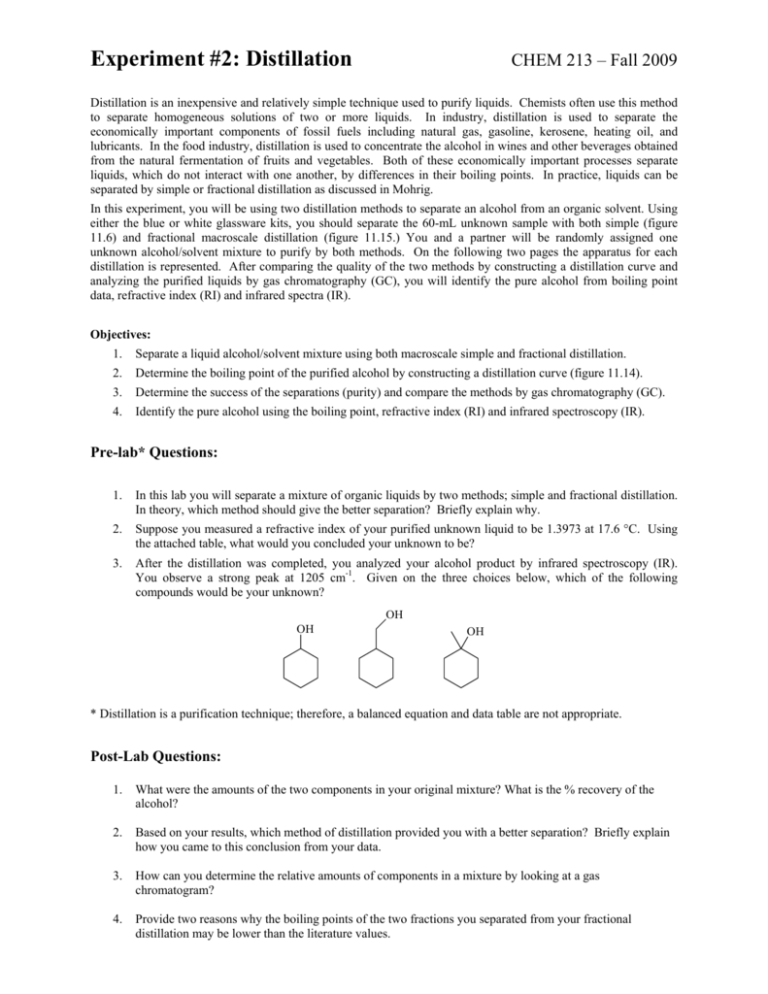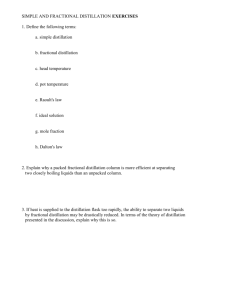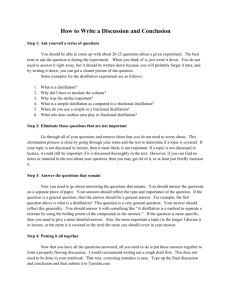Distillation
advertisement

Experiment #2: Distillation CHEM 213 – Fall 2009 Distillation is an inexpensive and relatively simple technique used to purify liquids. Chemists often use this method to separate homogeneous solutions of two or more liquids. In industry, distillation is used to separate the economically important components of fossil fuels including natural gas, gasoline, kerosene, heating oil, and lubricants. In the food industry, distillation is used to concentrate the alcohol in wines and other beverages obtained from the natural fermentation of fruits and vegetables. Both of these economically important processes separate liquids, which do not interact with one another, by differences in their boiling points. In practice, liquids can be separated by simple or fractional distillation as discussed in Mohrig. In this experiment, you will be using two distillation methods to separate an alcohol from an organic solvent. Using either the blue or white glassware kits, you should separate the 60-mL unknown sample with both simple (figure 11.6) and fractional macroscale distillation (figure 11.15.) You and a partner will be randomly assigned one unknown alcohol/solvent mixture to purify by both methods. On the following two pages the apparatus for each distillation is represented. After comparing the quality of the two methods by constructing a distillation curve and analyzing the purified liquids by gas chromatography (GC), you will identify the pure alcohol from boiling point data, refractive index (RI) and infrared spectra (IR). Objectives: 1. Separate a liquid alcohol/solvent mixture using both macroscale simple and fractional distillation. 2. Determine the boiling point of the purified alcohol by constructing a distillation curve (figure 11.14). 3. Determine the success of the separations (purity) and compare the methods by gas chromatography (GC). 4. Identify the pure alcohol using the boiling point, refractive index (RI) and infrared spectroscopy (IR). Pre-lab* Questions: 1. In this lab you will separate a mixture of organic liquids by two methods; simple and fractional distillation. In theory, which method should give the better separation? Briefly explain why. 2. Suppose you measured a refractive index of your purified unknown liquid to be 1.3973 at 17.6 °C. Using the attached table, what would you concluded your unknown to be? 3. After the distillation was completed, you analyzed your alcohol product by infrared spectroscopy (IR). You observe a strong peak at 1205 cm-1. Given on the three choices below, which of the following compounds would be your unknown? OH OH OH * Distillation is a purification technique; therefore, a balanced equation and data table are not appropriate. Post-Lab Questions: 1. What were the amounts of the two components in your original mixture? What is the % recovery of the alcohol? 2. Based on your results, which method of distillation provided you with a better separation? Briefly explain how you came to this conclusion from your data. 3. How can you determine the relative amounts of components in a mixture by looking at a gas chromatogram? 4. Provide two reasons why the boiling points of the two fractions you separated from your fractional distillation may be lower than the literature values. To get an early start in lab find the following items in your drawer (rather than stare at your Mohrig book for 20 minutes!) and set up as illustrated. A demo of both simple and fractional distialltion will be in lab for reference as well. Simple Distillation Red or black rubber stopper should hold thermometer Water out Just place the end of the tubing in the nearest sink or trough Rubber band together Water in Use lowest flow of water possible Red thin walled tubingi is best Rubber band together Always clamp the lowest point in an apparatus See your instructor for which heat source to use You are distilling 50 mL use 100 mL flask Leave open! You may use a supporting clamp here, but do not tighten or it will crack the still head! Assembled Rub ber band Water out Water in Rub ber b and Heat source To get an early start in lab find the following items in your drawer (rather than stare at your Mohrig book for 20 minutes!) and set up as illustrated. A demo of both simple and fractional distialltion will be in lab for reference as well. Fractional Distillation Red or black rubber stopper should hold thermometer Water out Just place the end of the tubing in the nearest sink or trough Rubber band together Water in Use lowest flow of water possible Red thin walled tubingi is best Rubber band together No water in this condenser - you will either pack the inside with Char-Boy or another packing (see instructor) Always clamp the lowest point in an apparatus See your instructor for which heat source to use Leave open! You are distilling 50 mL use 100 mL flask You may use a supporting clamp here, but do not tighten or it will crack the still head! Fractional distillations may need additional ring stands for support! Rub ber b and Water out Assembled Water in Rub ber b and Wrap this area in foil! Heat source Experiment #2: Distillation CHEMICAL NAME Methanol Ethanol 2-Propanol t-Butyl alcohol 1-Propanol 2-Butanol t-Amyl alcohol 2-Methyl-1-propanol 3-Methyl-2-butanol 3-Pentanol 1-Butanol 2-Pentanol 3-Methyl-3-pentanol 2-Methyl-1-butanol 3-Methyl-1-butanol 4-Methyl-2-pentanol 1-Pentanol Cyclopentanol 2-Methyl-1-pentanol 2-Ethyl-1-butanol 1-Hexanol Cyclohexanol (dry) FORMULA CH3OH CH3CH2OH CH3CH(OH)CH3 (CH3)3C(OH) CH3(CH2)2OH CH3CH(OH)CH2CH3 CH3CH2C(OH)(CH3)2 (CH3)2CHCH2OH CH3CH(OH)CH(CH3)2 CH3CH2CH(OH)CH2CH3 CH3(CH2)2CH2OH CH3CH(OH)CH2CH2CH3 CH3CH2C(CH3)(OH)CH2CH3 CH3CH2CH(CH3)CH2OH CH3CH(CH3)CHCH2CH2OH CH3CH(OH)CH2CH(CH3)CH3 CH3CH2CH2CH2CH2OH C5H9OH CH3CH2CH2CH(CH3)CH2OH CH3CH2CH(CH2CH3)CH2OH CH3CH2CH2CH2CH2CH2OH C6H11OH CHEM 213 – Fall 2009 BP °C (MP) 65 78 82 83(25) 97 98 102 108 112 116 118 119 123 129 130 132 136 139-40 148 149 157 160(24) nD25 1.3306 1.361 1.3752 1.386 1.384 1.397 1.405 1.394 1.3973 1.4103 1.3974 1.406 1.4166 1.41 1.406 1.4011 1.409 1.453 1.418 1.4224 1.418 1.465







